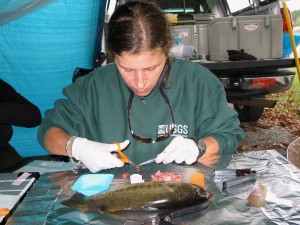Garden fresh tomatoes and crisp cucumbers.
A cool swimming hole and a paddle down the river.
A quiet evening fishing and a campsite by the creek.
What did you enjoy this summer? Whatever it was, chances are it depended on clean water. We often take clean water for granted these days, but not so long ago visibly polluted water was commonplace in America. The Clean Water Act came about only after an oil slick in Ohio’s Cuyahoga River caught on fire in 1969. Lined with factories and steel mills dumping waste directly into the river, the Cuyahoga had burned before. And it wasn’t the only river with astonishing levels of pollution. Others, such as the Nashua River in Massachusetts, flowed in Technicolor hues from dyes dumped directly into the water by mills. But many consider the 1969 Cuyahoga fire the spark that finally triggered federal action. Congress passed the Clean Water Act three years later with clear goals: to make all waters fishable and swimmable by 1983 and to eliminate the discharge of pollutants into navigable waters by 1985.
Today, we still haven’t met those goals. Rivers such as the Cuyahoga are vastly cleaner than they once were: the Clean Water Act requires factories and other point sources to limit their release of pollutants, and helps municipalities treat their sewage water before releasing it. But other problems remain. The Environmental Protection Agency reports that, of all the miles of rivers and streams assessed across the country, more than 64% don’t meet water quality standards necessary for harvesting and consuming fish (or other aquatic life) and 42% don’t meet water quality standards for recreation. That means no freshly caught fish for dinner over the campfire and no safe swimming holes.
Instead of dyes and oil from factories and steel mills, pollution today means bacteria, sediment, nutrients and metals from farms, power plants, erosion and development. And in recent years, scientists have discovered new pollutants such as endocrine disruptors that mimic female hormones. Pollution today is invisible to most of us – no rainbow-colored rivers or floating flames – making it easy to ignore. Scientists see female eggs forming in male bass, but the rest of us don’t. Chesapeake Bay watermen know when the Bay’s annual dead zone emerges, but most of us see only the white-capped waves on the surface.

With a little effort, anyone can look below the surface and learn more. For example, volunteers with Friends of the Shenandoah River can become citizen scientists, monitoring water quality at stations throughout the watershed, tracking pollutants and flagging areas needing attention. Farmers living off the land upstream can visit watermen living off the bay downstream through the Chesapeake Bay Program’s Farmers to the Bay program. Those wishing to modify their farming practices can work with the Natural Resources Conservation Service for solutions that reduce pollution entering the watershed.
Soon, in partnership with The Downstream Project, the Friends of the Shenandoah River will be making its online pollution information even easier to access and interpret. When they do, we’ll let you know.
So stay tuned and stay informed. Summer’s over, but the work of cleaning up our waterways goes on.


2 thoughts on “Summer’s End”